How Many Solar Panels To Power a House?
- Quick Estimate: Most Homes Need ~25 Panels (400W)
- Core Calculation Formula
- Estimation Tables
- Factors That Determine the Number of Solar Panels You Need
- Standard Test Conditions for Solar Panels
- How To Calculate the Number of Solar Panels You Need to Completely Power a Home
- Number of Solar Panels: Formula and Calculator
- Roof Space Required for Solar Panel Installation
- Energy Storage Solutions
- How Much Do Solar Panels Cost?
- Frequently Asked Questions
- Final Thoughts
In a time of increasing energy costs, extreme weather events, aging infrastructure, and climate uncertainty, homeowners are turning ever more frequently to clean, renewable solar energy to power their houses.
If you’re considering making a switch to solar, one of the first questions you’ll likely ask is, how many solar panels do I need to power my home?
The answer to this question depends on numerous factors — all of which we’ll cover below.
But first, let’s look at the requirements of the average American household.
According to the U.S. Energy Information Administration, the average American household in 2022 used “10,791 kilowatt hours (kWh), an average of about 889 kWh per month.”
Breaking it down, that equates to about 30kWh per day or 1.25kWh per hour on average.
In most parts of the United States, 10-20 400W solar panels should produce enough electricity to power a home without tapping into the utility grid.
Depending on the type and quality of manufacturing, a single 400W solar panel costs between $250 – $750. Using an average retail price of $500 per 400W rooftop solar panel — not including other requirements like a solar inverter or installation — 15 x 400W rigid solar panels will cost approximately $7,500 before tax.
Averages make for good rules of thumb, but how much will switching to solar energy cost YOU and how many PV modules do you need to meet your family’s electricity requirements?
What about all of the other essential components and installation costs?
Read on to find out.
Quick Estimate: Most Homes Need ~25 Panels (400W)
According to EcoFlow and industry benchmarks, the average U.S. household uses approximately 10,791 kilowatt-hours (kWh) of electricity annually—translating to roughly 30 kWh per day.
With EcoFlow’s 400W solar panels, and factoring in real-world conditions where each panel produces about 1.2 kWh per day (roughly 75% of its rated capacity), here’s a quick estimate:
Required Panels = Daily Consumption ÷ Daily Output per Panel
= 30 kWh ÷ 1.2 kWh ≈ 25 panels
In other words, most homes would need around 25 EcoFlow 400W solar panels to fully cover daily electricity needs.
Actual requirements may vary depending on your location, energy usage patterns, and available roof space—but this gives a realistic baseline for planning a whole-home solar setup.
Core Calculation Formula
Simplified formula to calculate the number of solar panels needed:
Number of panels = Daily energy consumption (kWh) ÷ Daily energy production per panel (kWh)
*An EcoFlow 400W solar panel produces an average of 2kWh of electricity per day in most regions, ranging from 1.2-3kWh
Estimation Tables
Solar Panels Needed by House Size (EcoFlow 400W Panels)
House Size | Estimated Panels | System Size | Recommended DELTA Battery |
1000 sq ft | 12-16 panels | 4.8-6.4kW | DELTA Pro or DELTA 3 Plus |
1500 sq ft | 14-20 panels | 5.6-8kW | DELTA Pro or DELTA Pro Ultra |
2000 sq ft | 16-24 panels | 6.4-9.6kW | DELTA Pro Ultra |
2500+ sq ft | 20-30 panels | 8-12kW | Multiple DELTA Pro Ultra |
Additional Panels Needed for Common Appliances/Uses
Appliance/Use | Extra Panels Needed | Recommended Battery |
Central AC | 4-6 panels | DELTA Pro |
EV Charging | 6-10 panels | DELTA Pro Ultra |
Pool Equipment | 3-5 panels | DELTA Pro |
Home Office | 1-2 panels | DELTA 2 or DELTA 2 Max |
Water Heater | 3-6 panels | DELTA Pro |
Solar Panels by System Size (EcoFlow 400W Panels)
System Size | Number of EcoFlow 400W Panels | Daily Generation (est.) |
5kW System | 13 panels | 20kWh |
8kW System | 20 panels | 32kWh |
10kW System | 25 panels | 40kWh |
12kW System | 30 panels | 48kWh |
Roof Space Required for Solar Panel Installation
Number of Panels | Roof Space Required (approx.) |
10 EcoFlow 400W panels | 200 sq ft |
15 EcoFlow 400W panels | 300 sq ft |
20 EcoFlow 400W panels | 400 sq ft |
25 EcoFlow 400W panels | 500 sq ft |
30 EcoFlow 400W panels | 600 sq ft |
The tables above offer a quick snapshot to help you gauge your setup.
But if you're aiming for precision, keep reading—we’ll walk through how to calculate the exact number of panels your home needs.
Let's start with the key factors.
Factors That Determine the Number of Solar Panels You Need
What factors determine the number of solar panels your home needs?
It’s a long list.
Let’s start at the top with the most crucial and work our way down.
Determine Your Energy Consumption
The first step in determining how many solar panels you need to power your house actually has very little to do with solar panels. Instead, it’s essential to accurately determine your current household electricity consumption.
If you don’t know what appliances and household systems like HVAC you want to operate using solar power, you have no starting point to work from.
We’ll cover how to estimate your household electricity needs below.
Peak Sunlight Hours
Solar panels produce Direct Current (DC) electricity by capturing sunlight using the photovoltaic effect.
No photovoltaic (PV) module ‘works’ at night.
Not only that, but on overcast or cloudy days, electricity production from your solar panel array will diminish significantly.
The rated power of solar panels is determined in a laboratory using Standard Test Conditions.
Standard Test Conditions for Solar Panels
Condition Type | Standard Test Condition | Real-World Conditions |
Solar Incident Angle | Always zero, irradiation beam always normal to the PV panel* | Variable, and depends on time, date, and site latitude. In the case of rooftop systems, roof orientation, and inclination govern system capacity. |
Solar Irradiation | Always equal to 1000 Watts/m²* | Variable and depends on the time, date, and site latitude. Limited sunshine hours bound system capacity. |
Ambient Temperature | Always 25°C* | Variable and depends on the time, date, weather condition, and site latitude. Higher ambient temperature degrades PV panel efficiency and reduces system output. |
Air Mass Coefficient (AM) | Always equal to 1.5* | Variable and depends on the time, date, and site latitude. Higher AM with higher latitudes. |
System Losses(e.g., Wiring, Inverter) | Always Zero* | Variable and depends on the design and location of PV panels, inverter, and grid meter. |
*Cannot be achieved in real operation (Source: ResearchGate)
Consumers benefit from standardized testing. It helps keep manufacturers accountable for claims about product capabilities.
However, real-world conditions rarely (if ever) match Standard Test Conditions.
The closest most locations get is during peak sunlight hours where solar irradiance (sunshine) may approach or exceed 1000 Watts/m².
If you’re in the US, you can estimate the number of peak sunlight hours here.
Size of Your Home
Your home’s size impacts the number of solar panels you require in several ways.
- Electricity Consumption: As a rule of thumb, the bigger the house, the more electricity is consumed. That’s particularly true if you’ll be running heating or air-conditioning systems using solar power.
- Available Surface Area for Installation: Photovoltaic modules like solar panels can be installed virtually anywhere there’s direct sunlight. However, the vast majority of homeowners choose to install PV panels on their roofs. Ground installations are also common on properties that have sufficient space. The amount of surface area that receives direct sunlight and is suitable for solar panel mounting determines the maximum number of solar panels you can install to meet your renewable electricity needs.
On or Off-Grid (or Hybrid)?
Depending on your location — and your local utility provider — you may be able to opt for a grid-tied residential solar power system.
The difference between on-grid and off-grid solar is largely a question of energy independence and security.
A grid-tied system integrates with your electricity provider or utility company. At times when your solar panel array isn’t producing enough power to meet your needs, your system will automatically switch to on-grid electricity.
Depending on where you live, you may also be eligible for net metering.
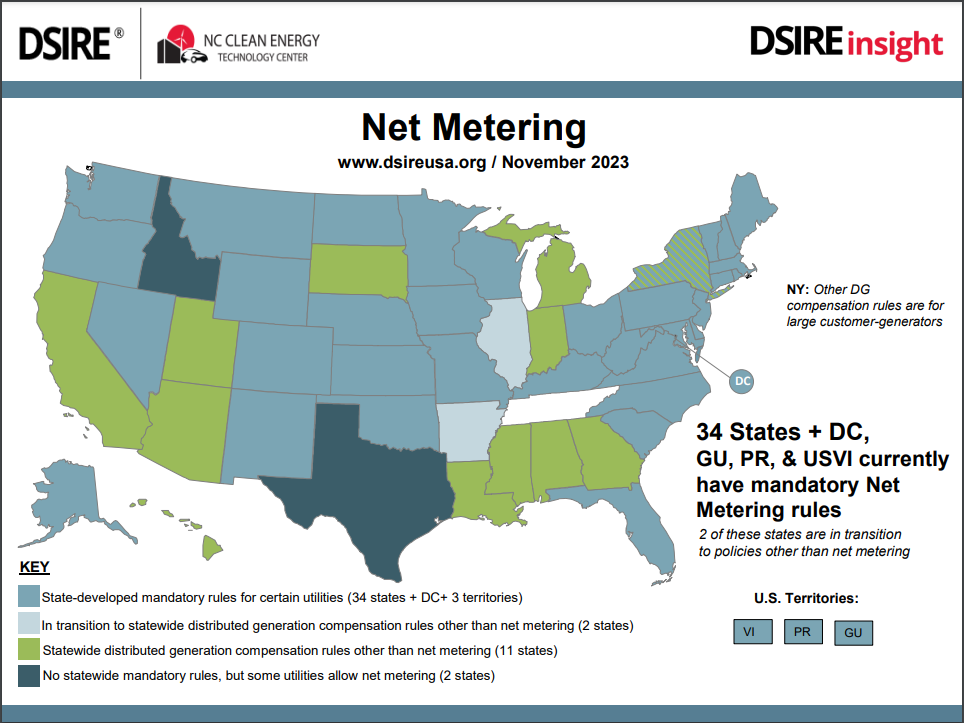

As of November 2023, 34 states + Washington DC, and 3 territories have mandatory net metering programs.
The specifics vary by location — and by utility — but the basic principles remain the same.
Net metering enables residential and commercial generators of renewable electricity — like solar power — to sell electricity back to the grid through a bidirectional (or smart) meter.
For homeowners, it’s rare to actually make money through net metering, but it can substantially reduce electricity bills.
There are advantages to on-grid systems without storage, the main one being savings on the expense of solar batteries and other balance of system components like an MPPT or PWM charge controller or storage inverter.
However, skimping on battery storage exposes an essential flaw of grid-tied systems. On-grid solar panel systems rely on the grid to operate. A grid-tied solar power system does NOT provide electricity during a blackout.
If you’re concerned about energy security during extreme weather events and grid failures, you’re much better off opting for a grid-tied system with solar battery storage.
For example, the EcoFlow DELTA Pro Ultra offers up to 90kWh of LiFePO4 solar battery storage and 7.2kW continuous AC output (10.8kW peak output for 10 seconds).
You can add up to three inverters for AC output of up to 21.6kW. You can operate your entire home on or off-grid with enough battery storage for up to a month.
EcoFlow DELTA Pro 3 and DELTA Pro Ultra feature proprietary X-Core 3.0 tech architecture, providing industry-leading performance, safety, and intelligence.
X-Core 3.0 delivers the following benefits.
- X-Stream delivers record-speed charging — only 50 minutes
- X-Boost’s revolutionary soft-start algorithm supports up to 6000W of appliances and central HVAC systems with just one unit
- X-Link parallel expansion provides up to 21.6kW of output power and 90kWh of electricity storage
- X-Quiet volume minimization means whisper-quiet operation at an industry-best 30dB*
- X-Fusion outpowers the grid by providing up to 7000W of electricity output from a single AC outlet in bypass mode. Standard household plugs deliver only 1800W. Plug in EcoFlow DELTA Pro 3 or DELTA Pro Ultra and increase your output by close to 300%
- X-Guard is a protective triad of structure, material, and AI that keeps your home and family safe. It can even self-extinguish in the unlikely event of a fire.
Find out more about X-Core 3.0 here.
Think of EcoFlow DELTA Pro Ultra as a hybrid solar generator. You can run your entire home on or off-grid. Connect up to 42 x EcoFlow 400W rigid solar panels to capture all the electricity you need AND benefit from net metering if available.
Budget and Solar Payback
Last but not least, cost is an essential factor to consider when determining how many solar panels you require.
Fortunately, there’s never been a better time to switch to solar power for your residential electricity needs.
If you’re a US taxpayer and you’re installing solar panels at your primary or secondary residence, up to 30% of the total cost of the PV modules, balance of system, installation, and almost any other associated fees can be deducted from your personal income tax.
Thanks to the Residential Clean Energy Credit — also known as the Federal Solar Tax Credit — all-in-one solar power solutions like EcoFlow DELTA Pro Ultra and DELTA Pro can be combined with as many solar panels as you need at a discount of up to 30%.
The credit can only be applied to new installations that are purchased — not leased or rented. However, if you finance the system through a manufacturer like EcoFlow, you can still receive the 30% credit.
There’s no maximum amount eligible for the credit, and you can apply for it multiple times if you end up adding more electricity generation capacity in the future.
Depending on where you live, for example, in California, Florida, or Texas, there may be additional local and state tax incentives available.
By offsetting the upfront cost of switching to solar with government incentives, you can significantly shorten your solar payback period. The sooner you pay off the cost of your residential solar power system, the sooner you start realizing a positive return on investment.
Money saved on electricity bills becomes money earned.
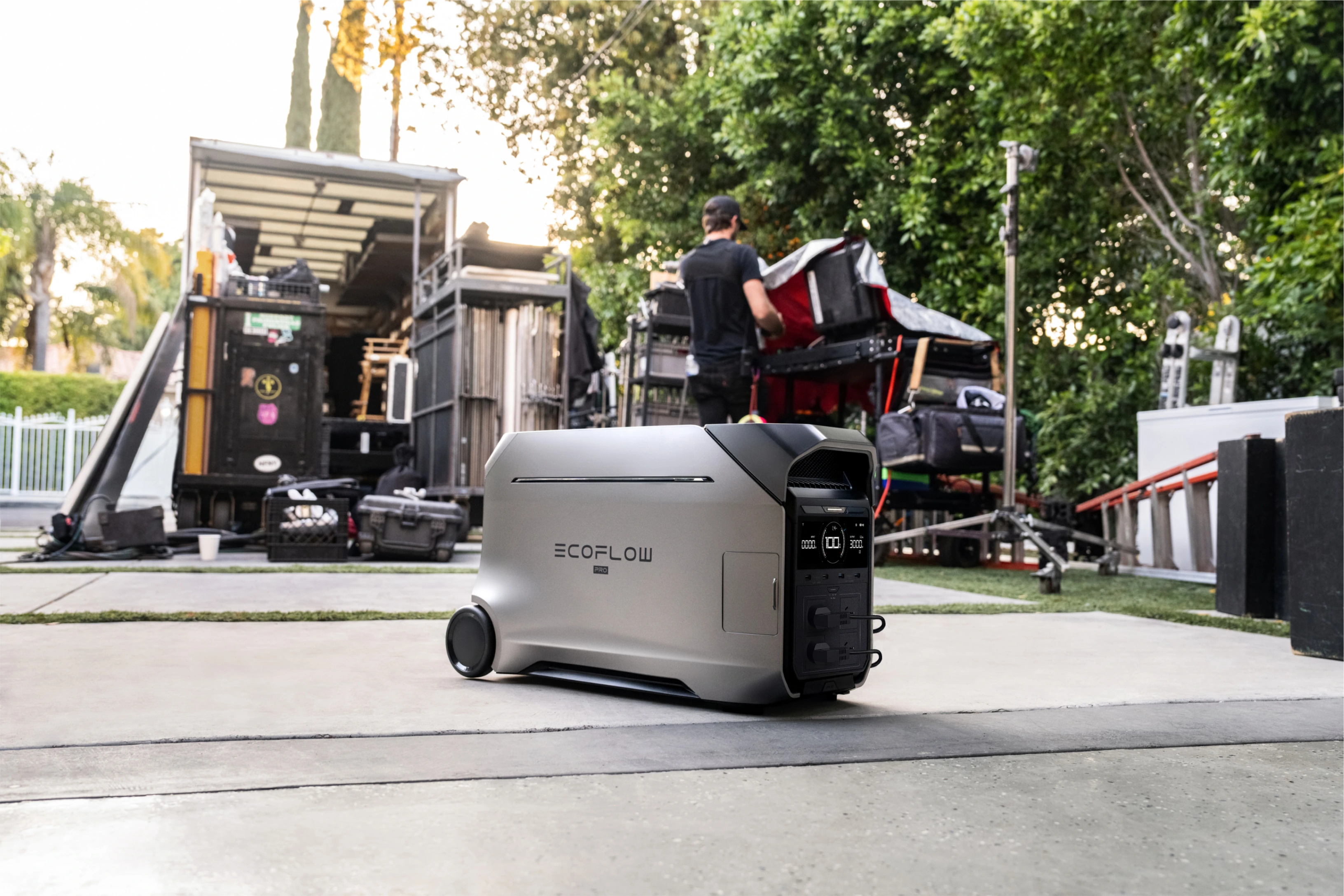

How To Calculate the Number of Solar Panels You Need to Completely Power a Home
Have you determined the following factors?
- Total household electricity consumption (in kWh) and the percentage you want to generate with solar panels
- Average peak sun hours at your location
- Available surface area and method of installation
- On-grid, off-grid, or hybrid (PV modules + solar battery) balance of system
- Solar panel type and efficiency
- Your budget (less available government solar incentives)
If the answer is yes, it’s time to combine everything you’ve learned to estimate how much electricity any given solar panel array can generate.
Here’s how to do it.
Electricity Production Requirements in Kilowatt-Hours (kWh)
First, take the number of watt-hours (Wh) that your PV array must generate to meet your specific needs. As mentioned above, the average American household uses about 1.25kWh per hour. Let’s take that as a starting point.
1.25kWh (hourly consumption)
Solar Irradiance and Peak Sun Hours
Next, take the number of peak sunlight hours at your location.
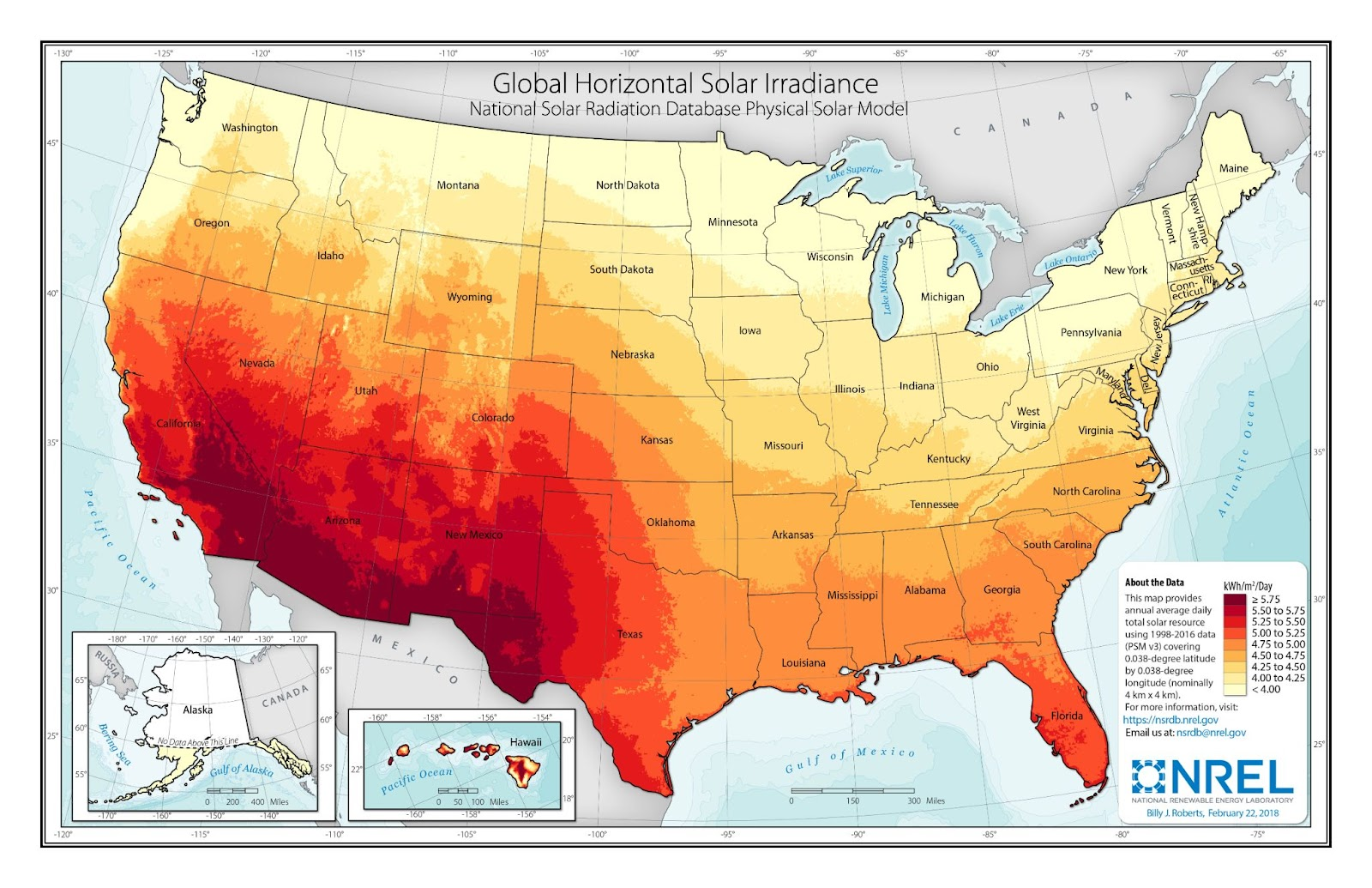

(Source: NREL)
Solar irradiance varies widely by state — and even within states. The above map shows Global Horizontal Irradiance (GHI) and the projected electricity production per m2 (square meter) of photovoltaic surface.
Solar Panel Type and Efficiency
While a useful reference, the GHI makes too many assumptions regarding the type of solar panels (and cells) being used.
The most common types of solar cells found in residential solar installations are:
- Monocrystalline
- Polycrystalline
- Thin-film
Monocrystalline silicon solar cells are significantly more efficient at producing DC electricity from available sunshine than polycrystalline or thin-film photovoltaic cells.
Aside from its meaning in common usage, solar panel efficiency is a technical specification that indicates how much electricity solar cells can produce per m2 of photovoltaic surface area. The higher the efficiency percentage, the more photons will be captured by the panel and converted into DC electricity.
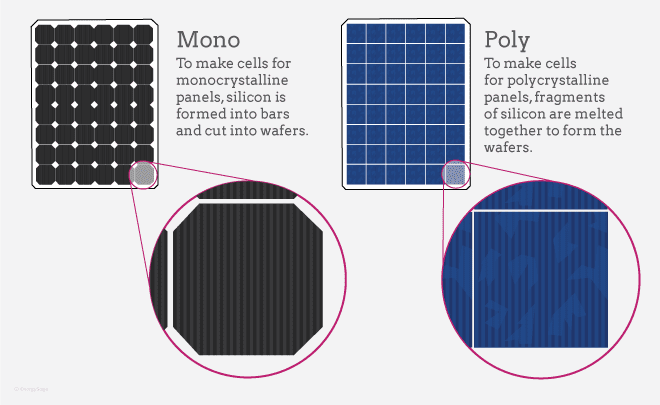

(Source: ASES)
Solar Panel Type | Efficiency (%) |
Monocrystalline | 18-23% |
Polycrystalline | 15-17% |
Thin-film | 7-18% |
As you can see, there’s a huge variation in efficiency depending on the panel type. Monocrystalline solar panels that have 23% efficiency will produce over 3x as much electricity per square meter as thin-film PV panels that have a rating of 7%.
Find out more about the different types of solar panels here.
Number of Solar Panels: Formula and Calculator
Solar panel efficiency varies widely based on the panel type, quality of manufacture and other factors like temperature.
To calculate how many solar panels you need, you have to get specific about both your requirements and the electricity production capabilities of the photovoltaic module you’re considering purchasing.
At best, the results of your calculations will be a working estimate. Real-world conditions are impossible to predict with absolute certainty. It’s always wise to slightly overestimate how many PV modules you need. Or at least ensure that your solar generator or balance of system has sufficient solar charging or power input that allows you room to grow.
Here’s the two-part formula to calculate the number of EcoFlow’s 400W rigid solar panels you would need to generate a daily average of 30kWh in California (6.25 peak sun hours).
30kWh / 6.25 = 4.8kW
The EcoFlow 400W rigid solar panel generates 0.4kW per hour of peak sunlight in a lab without taking any other environmental considerations into account. Even though this monocrystalline solar panel boasts industry-leading efficiency of 23%, it will rarely output that much electricity per hour.
The rated power of solar panels indicates the maximum amount of electricity a module can produce under ideal conditions.
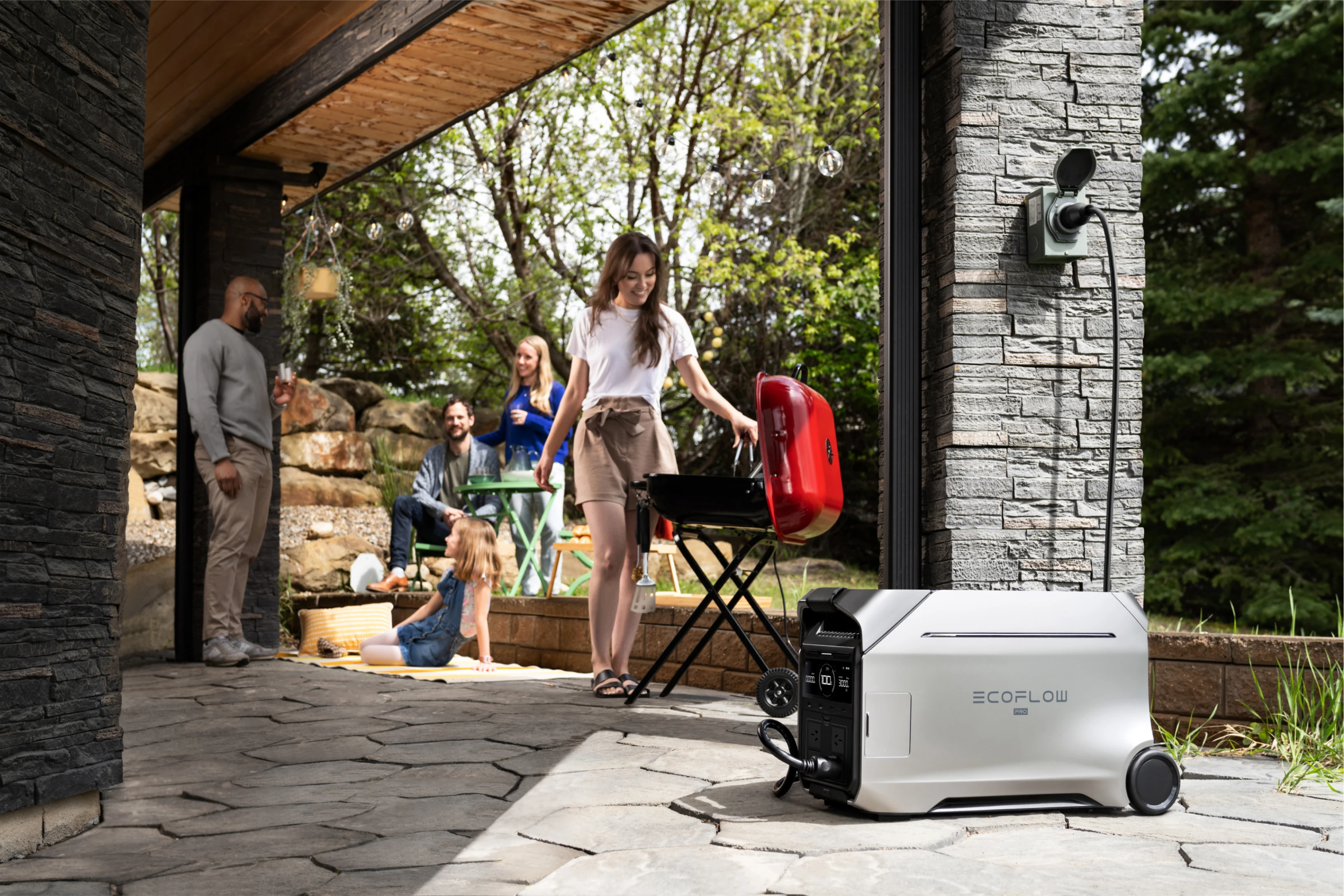

It’s much safer to assume that the panel will produce 75% of its rated power during peak daylight. Solar panels rarely produce their maximum rated power in real-world conditions.
0.4kW x .75 = 0.3kW (per panel)
4.8kW / 0.3kW = 16 x EcoFlow 400W rigid solar panels
You may produce MORE electricity per day, but you’re unlikely to produce less, except during extreme weather conditions or other external factors that can diminish efficiency.
If you’d like to plug in your own numbers, the two-part formula is:
Daily Electricity Consumption/Average Peak Sun Hours = Required Electricity Production (in kilowatts)
Required Electricity Production / (Rated Power of PV Module x 0.75) = Number of Solar Panels
Or you can use our handy solar panel calculator:
Daily Electricity Consumption: Enter Consumption (kWh) Average Peak Sun Hours: Enter Sun Hours Rated Power Output of Solar Panel: Enter Rated Power (W) Calculate Solar Panels Reset |
|---|
Roof Space Required for Solar Panel Installation
Ensuring you have enough roof space to install the required number of solar panels is also important. EcoFlow 400W rigid solar panels measure approximately 79 inches x 32 inches (2016mm x 828mm), which equals about 17.5 square feet per panel.
Using the example of 15 solar panels above, you would need approximately 262.5 square feet (17.5 square feet x 15) of roof space. This doesn't include space needed between panels and areas of your roof that may not be suitable for installation (such as around chimneys). A good rule of thumb is to allocate about 20 square feet of roof space per EcoFlow 400W solar panel.
If your available roof space is limited, you might:
- Choose higher-efficiency solar panels
- Consider ground-mounted options
- Install fewer solar panels and combine with grid power
Energy Storage Solutions
Solar panels only generate electricity when the sun is shining. To have power around the clock, you need a storage system to store excess electricity.
EcoFlow offers various storage options suitable for different sizes of solar systems:
- EcoFlow DELTA 2: 1-3kWh capacity, suitable for smaller systems
- EcoFlow DELTA Max: 2-6kWh capacity, suitable for medium-sized systems
- EcoFlow DELTA Pro: 3.6-25kWh capacity, suitable for larger systems
- EcoFlow DELTA Pro Ultra: 7.2-90kWh capacity, suitable for whole-house systems
The size of your storage system should be based on your daily energy consumption and how many days of backup you want. For example, if you want two days of backup power during cloudy weather and you use 30kWh per day, you would need a storage system of at least 60kWh.
How Much Do Solar Panels Cost?
The retail price of solar panels varies widely. Whole home solar power systems typically use 400W PV panels.
The cost of 400W rigid solar panels is typically between $250 – $750, depending primarily on:
- Type of solar cells (monocrystalline or polycrystalline silicon)
- Efficiency
- Quality of materials and manufacture
As with most significant purchases, you typically get what you pay for. If you opt for low-end solar panels, your long-term return on investment is likely to be lower too.
Solar panels last for 25 years or more. Investing extra upfront for panels that produce more electricity pays off in the long run.
As of January 2024, the EcoFlow 400W rigid solar panel is available directly from the manufacturer for $500 ($999 for 2 x 400W rigid solar panels).
Frequently Asked Questions
Q1: How Many Solar Panels Do I Need for a 2000 Sq Ft Home
A: Trying to determine how many solar panels you require using the square footage of a residence alone is highly inaccurate and likely to lead to costly mistakes. Depending on the number of residents and their usage patterns, electricity consumption — and thus the number of solar panels — will vary widely. An extremely rough estimate is between 14 and 25 400W solar panels.
Q2: Can 1 Solar Panel Power a Whole House?
A: No. One 400W solar panel can see you through an off-grid camping adventure but no commercially available single PV module can provide enough electricity to power an entire home. The average American household needs 15 – 25 x 400W solar panels to generate enough electricity to independently power their residence.
Q3: What If My Roof Is Too Small?
A: If roof space is limited, consider these options:
- Use higher efficiency panels to generate more power in a limited space
- Consider partial solar power (grid-tied system) rather than full solar dependency
- Explore ground-mounted options if you have available yard space
- Prioritize powering your most important appliances rather than the entire house
Q4: How Much Can One 400W Solar Panel Power?
A: A single EcoFlow 400W solar panel can generate approximately 2kWh of electricity per day under ideal conditions, enough to power a laptop, smartphone, LED lights, and small appliances like fans or a mini-refrigerator for several hours. However, one panel isn't sufficient to power an entire household. Most homes need at least 15 such panels to meet typical energy needs.
Q5: Will the System Work on Cloudy or Rainy Days?
A: Yes, solar panels still generate electricity on cloudy days, though output will be reduced to about 10-25% of normal production. This is why proper energy storage is essential for ensuring power availability at all times. EcoFlow DELTA series can store excess electricity generated on sunny days for use when light conditions are poor.
Q6: Can I Install a Solar System in Phases?
A: Yes, many homeowners choose to install their solar systems in phases to spread out the cost. You can start with a smaller system covering part of your energy needs and then expand the system as funds allow. EcoFlow's modular design makes future expansion easy.
Q7: How Much Money Can an EcoFlow Solar System Save Me?
A: Depending on your current electricity rates, energy consumption, and location, a whole-house EcoFlow solar system can save you $50-200 per month on electricity bills. On average, solar systems have a payback period of 6-10 years, while the systems themselves last 25+ years, meaning over 15 years of "free" electricity.
Final Thoughts
Thanks to rapidly improving technology, falling prices, and generous government tax breaks of up to 30%, among other incentives, there’s never been a better time to invest in renewable energy.
Not only can you achieve energy independence and a substantial return on investment, but you’re also investing in your family’s future. And the future of our warming planet.
EcoFlow’s innovative residential solar power solutions offer industry-leading performance and quality.
EcoFlow 400W rigid solar panels offer 23% efficiency, IP68 waterproof rating, and years of superior performance and durability. They’re seamlessly compatible with the EcoFlow DELTA series of whole home generators as well as most third-party balance systems.
Check out EcoFlow’s home battery backup and solar generator solutions today.
*Under 2000W output